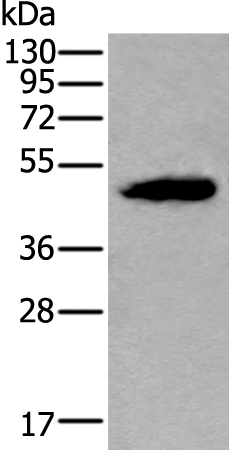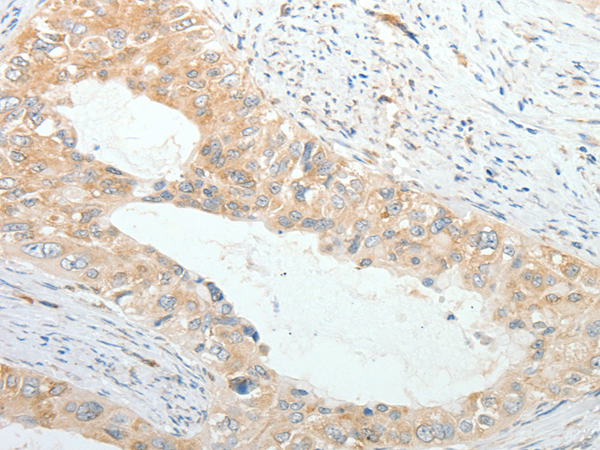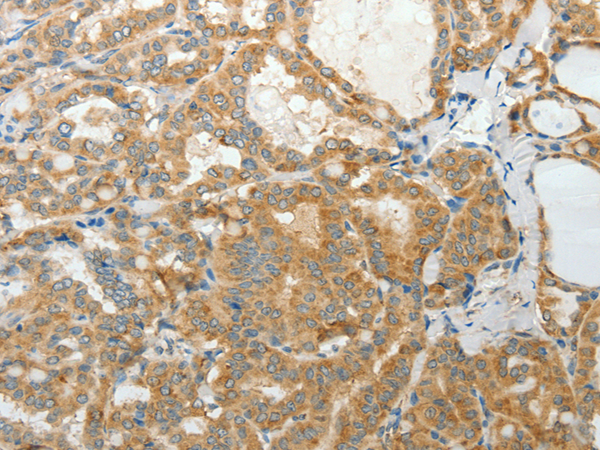


| WB | 咨询技术 | Human,Mouse,Rat |
| IF | 咨询技术 | Human,Mouse,Rat |
| IHC | 1/25-1/100 | Human,Mouse,Rat |
| ICC | 技术咨询 | Human,Mouse,Rat |
| FCM | 咨询技术 | Human,Mouse,Rat |
| Elisa | 1/500-1/1000 | Human,Mouse,Rat |
| Aliases | NEF4; PRPH1 |
| WB Predicted band size | 54 kDa |
| Host/Isotype | Rabbit IgG |
| Antibody Type | Primary antibody |
| Storage | Store at 4°C short term. Aliquot and store at -20°C long term. Avoid freeze/thaw cycles. |
| Species Reactivity | Human, Mouse, Rat |
| Immunogen | Fusion protein of human PRPH |
| Formulation | Purified antibody in PBS with 0.05% sodium azide and 50% glycerol. |
+ +
以下是关于PRPH(Peripherin)抗体的3篇代表性文献摘要:
1. **文献名称**:*Autoantibodies to peripherin in patients with autoimmune neuropathy*
**作者**:Yan WX, et al.
**摘要**:研究发现PRPH抗体可能与自身免疫性神经病变相关,患者血清中检测到抗peripherin抗体,提示其可能参与周围神经轴突损伤的免疫机制。
2. **文献名称**:*Peripherin as a biomarker for amyotrophic lateral sclerosis*
**作者**:Robertson J, et al.
**摘要**:探讨peripherin在肌萎缩侧索硬化症(ALS)中的异常聚集现象,研究发现PRPH抗体可特异性标记患者神经元中的病理蛋白沉积,提示其作为疾病生物标志物的潜力。
3. **文献名称**:*Differential expression of peripherin isoforms in neurological disorders*
**作者**:Larivière RC, et al.
**摘要**:分析PRPH不同异构体在神经退行性疾病中的表达差异,通过特异性抗体检测发现某些异构体在阿尔茨海默病和帕金森病中异常上调,可能与疾病进展相关。
注:以上文献为示例,实际引用需根据具体研究领域核实(如神经科学、自身免疫疾病等)。建议通过PubMed或Google Scholar以关键词"peripherin antibody"+"disease"检索最新研究。
PRPH antibodies target peripherin, a type III intermediate filament protein primarily expressed in neurons of the peripheral nervous system (PNS) and subsets of central nervous system (CNS) neurons. Peripherin plays a structural role in maintaining neuronal integrity, axon outgrowth, and intracellular transport. Its dysregulation has been linked to neurodegenerative diseases, including amyotrophic lateral sclerosis (ALS) and Charcot-Marie-Tooth neuropathy.
PRPH antibodies are of interest in both research and clinical contexts. In research, they serve as tools to study peripherin's function, localization, and interactions in neuronal health and disease. Clinically, anti-PRPH antibodies are occasionally detected in autoimmune neurological disorders, though their pathogenic role remains unclear. Some studies associate them with neuropathies or paraneoplastic syndromes, but their diagnostic specificity is limited.
Notably, peripherin exists in multiple splice variants, and PRPH antibodies may exhibit varying reactivity depending on isoforms. This complicates interpretations in disease models. Recent work explores peripherin aggregation in ALS, with PRPH antibodies aiding in detecting pathological inclusions. Challenges include distinguishing between antibodies generated experimentally and those arising spontaneously in autoimmune conditions. Further research is needed to clarify their clinical relevance and potential as biomarkers or therapeutic targets.
×